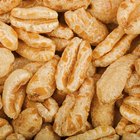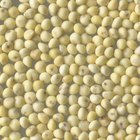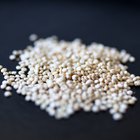Grits have evolved from a Native American food to become a staple of the diets of many Americans. The “Grit Belt” includes the southern states from Texas to Virginia, according to Santa Rosa’s "Press Gazette." The Florida Panhandle city takes its grits seriously, boasting its own grit-eating contest, while St. George, South Carolina, calls itself the “Grits Capitol of the World” and holds an annual World Grits Festival.
Creation
Corn grits are coarsely ground corn. Yellow grits are made from yellow corn. Corn grits can be made from white or yellow corn, but you can also make wheat, rice or other forms of grits. In consistency, the grind is larger than that of cornmeal; the "Cook’s Thesaurus" likens the grind of grits to that of sand. Traditionally, corn was taken to mill for grinding; corn ground fine enough to pass through the mills' screens was used as meal and the larger pieces used as grits, according to Santa Rosa’s "Press Gazette."
Yellow vs. White
Additionally, yellow grits use the whole kernel of corn, whereas white grits have had the hull removed. According to The Old Mill website, yellow grits have more corn flavor and a smoother texture than white grits, and northerners tend to favor yellow grits, while southerners prefer white grits. The Old Mill company operates a 175-year-old water-powered gristmill that still produces ground grains today.
Hominy Grits
hominy grits are also made from yellow or white corn, but the corn has been soaked and cooked in an alkaline solution and hulled, and the bran and germ removed before use. Yellow hominy is considered a sweeter version than white hominy. Samp is a more coarse version of hominy, while hominy grits are ground to a fine consistency.
Preparation
Grits may be purchased in the grocery store in instant form for quick preparation, but the long-cooking variety is considered better quality by traditionalists. Grits are prepared by boiling a liquid -- which may be water, milk, cream, stock or a combination of these ingredients -- along with seasonings and butter or grease and slowly adding the grits while stirring. The mixture is cooked for approximately 20 minutes over a lower heat. Grits are usually boiled until they thicken into a porridge or oatmeal consistency.
Combinations
While grits are most commonly used as a hot breakfast food, grits hold a prominent place in soul food and southern dishes. They are also used as a side or a pairing with dishes containing very heavily spiced ingredients. Grits may be eaten covered in gravy, cheese or butter and salt or served with seafood, meats or vegetables. Grits may be served and eaten hot or cold.
Related Articles

Bulgar Wheat Vs. Couscous

Quaker Oats Instant Grits: Nutritional ...

What Are Hominy & Grits?

What Is White Oat?
Cooking Instructions for Cracked Wheat

How to Cook With Kamut

Can You Use Matzo Flour to Thicken ...

How to Cook Millet Meal
How to Cook Grits in the Microwave

How to Cook Couscous With Chicken Broth

What Is Indian Flatbread Called?
Are Masa & Fine Cornmeal Used for ...
Creamy Shrimp and Grits Recipe

How to Eat Buckwheat Raw

Difference Between Soba and Udon Noodles

What Is the Difference Between Rolled ...

How to Cook Soaked Hulled Barley

How to Make Corn Soup

How to Cook Quinoa Flakes for Breakfast

What Type of Food Do People in Honduras ...